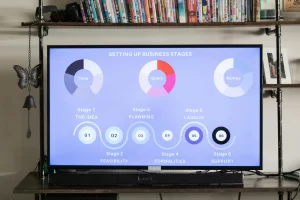As a homeschooling mom, full-time employee, and wife, I often find myself in the position of convincing someone to do something new — whether it’s a client at work or one of my kids at home.
If you’re planning to homeschool while working full-time, one thing is certain: your family’s day-to-day flow will change. And even when everyone agrees on what that change should look like, shifting into a new rhythm can still be hard.
What’s helped me most is something I didn’t expect — blending strategies from my professional life into my home life.
In my field, we use a powerful model to help people adopt change (i.e., help people to be able to do something differently from what they’re used to). It’s called the ADKAR Model, and it’s all about making change stick by focusing on why the change matters and how to support someone through it.

What is the ADKAR Model?
ADKAR is an acronym that stands for:
- Awareness – understanding the need for change
- Desire – wanting to participate in the change
- Knowledge – knowing how to change
- Ability – being able to implement new skills or behaviors
- Reinforcement – making the change stick over time
It’s typically used in business settings, but I’ve found it incredibly useful in everyday family life too — whether I’m setting up a new routine, encouraging independence, or simply trying to make things run more smoothly.
Here are a few examples of how you can apply the ADKAR model to common home life changes:
 1. Establishing a Family Chore Routine
1. Establishing a Family Chore Routine
- Awareness: One person (usually you!) is overwhelmed — something needs to shift.
- Desire: Everyone sees the benefits of shared responsibility and a cleaner space.
- Knowledge: Kids learn age-appropriate chores like folding laundry or setting the table.
- Ability: With guidance and practice, they become more confident doing chores.
- Reinforcement: Use praise, sticker charts, or a family movie night to celebrate consistency.
 2. Creating a Morning Routine for Yourself
2. Creating a Morning Routine for Yourself
- Awareness: You’re tired of starting the day feeling rushed and frazzled.
- Desire: You crave more peace, energy, and control over your mornings.
- Knowledge: Explore routines that work for your lifestyle — maybe quiet time, stretching, or journaling.
- Ability: Start small — wake up 10 minutes earlier, prep the night before, adjust as needed.
- Reinforcement: Track your streak, reflect on how you feel, and reward your consistency.
 3. Building a Family Budget and Saving Plan
3. Building a Family Budget and Saving Plan
- Awareness: Overspending is causing stress — you need more intentional financial habits.
- Desire: You want to save for a goal (like a trip) or reduce debt for peace of mind.
- Knowledge: Learn how to budget and track spending as a team.
- Ability: Try using a budgeting app together and refine it over time.
- Reinforcement: Celebrate financial wins like paying off a credit card or sticking to a budget.
 4. Transitioning to Healthier Family Meals
4. Transitioning to Healthier Family Meals
- Awareness: You’re all feeling sluggish — time to fuel your bodies better.
- Desire: Everyone wants more energy and to learn how to cook healthy meals together.
- Knowledge: Research simple, nutritious recipes and plan meals as a family.
- Ability: Start small — like introducing “Meatless Mondays” or cooking together once a week.
- Reinforcement: Add favorite meals to the regular rotation, and let each person choose a healthy dish.
 5. Reducing Screen Time for the Whole Family
5. Reducing Screen Time for the Whole Family
- Awareness: You notice more irritability, distraction, or disconnection.
- Desire: Your family wants more meaningful time together — games, outdoor play, focused schoolwork.
- Knowledge: Learn about healthy screen-time boundaries and draft a family agreement.
- Ability: Set limits, offer fun alternatives, and lead by example.
- Reinforcement: Reflect each week, and celebrate screen-free wins with a family activity.
 Potty Training with ADKAR
Potty Training with ADKAR
Yes — even potty training can benefit from the ADKAR model! Here’s how:
- Awareness:
Help your child understand what the potty is and why they’ll be using it.
Examples: Read books, watch videos, or say, “Diapers are for babies. You’re getting so big!” - Desire:
Make them want to try by making it exciting and rewarding.
Examples: Let them pick underwear, use fun songs or sticker charts, and talk about growing up. - Knowledge:
Teach them the steps — clearly and consistently.
Examples: Demonstrate or use a potty doll, and post a visual routine chart. - Ability:
Give them time and the tools to succeed.
Examples: Stay home for practice, use easy-off clothes, and celebrate tiny wins. - Reinforcement:
Keep it going with encouragement and calm support.
Examples: Offer praise, stay consistent with reminders, and remain patient through accidents.
 Summary Example (Potty Training):
Summary Example (Potty Training):
| ADKAR Step | Example |
| Awareness | “You’re growing up! Soon, no more diapers.” |
| Desire | Letting them choose their own fun underwear |
| Knowledge | Teaching the routine with visuals and stories |
| Ability | Practice sessions at home with your support |
| Reinforcement | Rewards, praise, and calm consistency |
Whether you’re navigating homeschool, parenting milestones, or just trying to reclaim your mornings, the ADKAR model offers a powerful and practical framework. Change is hard — but with the right mindset and structure, it can become not only manageable, but meaningful.

Please comment below to let me know if you’ve used a similar approach — or want help applying this model to a challenge in your own home!
